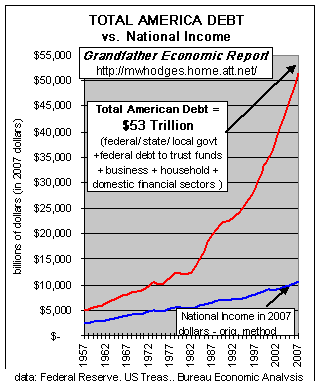President Predicting Catastrophe
President Obama declared today that “A failure to act and to act now will turn crisis into catastrophe and guarantee a longer recession.”
Alan Blinder, a former vice chairman of the Federal Reserve, echoed the President by proclaiming “It would be an act of extreme stupidity not to enact a big stimulus”. Mr Blinder did not expound on the logic of his remark. Presumably, if you were too stupid not to vote for spending one trillion dollars, then you would be too stupid to understand his rationale.
A short 6 months ago President Bush, Chairman Bernanke and Treasury’s Paulson were predicting a financial meltdown if the $700 billion TARP bill did not pass. The $700 billion was approved and the money passed out to banks and other assorted supplicants. How wisely was the $700 billion spent? All we do know is that the bankers managed to pay themselves huge bonuses, the money is gone and we now face financial Armageddon (again) if we do no spend another massive amount of borrowed money. All we really know about the new, almost $1 trillion dollar “stimulus package”, is that it must be passed immediately, no questions asked. Maybe more questions should have been asked the first time, when $700 billion was supposed to have solved the financial crisis.
Bernanke Proclaims Financial Crisis Resolved: October 2008
In October 2008, after passage of the $700 billion TARP bill, Chairman Bernanke spoke at the Economic Club of New York.
“The problems now evident in the markets and in the economy are large and complex, but, in my judgment, our government now has the tools it needs to confront and solve them.
Generally, during past crises, broad-based government engagement came late, usually at a point at which most financial institutions were insolvent or nearly so. Waiting too long to respond has usually led to much greater direct costs of the intervention itself and, more importantly, magnified the painful effects of financial turmoil on households and businesses. That is not the situation we face today. Fortunately, the Congress and the Administration have acted at a time when the great majority of financial institutions, though stressed by highly volatile and difficult market conditions, remain strong and capable of fulfilling their critical function of providing new credit for our economy. This prompt and decisive action by our political leaders will allow us to restore more normal market functioning much more quickly and at lower ultimate cost than would otherwise have been the case.
Reading the Chairman’s comments today, we know that his assessment of the situation was wrong. TARP 2008 did not resolve anything nor will the stimulus package of 2009.
Did the original $700 billion “save” our country from a “catastrophe”?. In hindsight, much of the money spent was wasted on zombie banks that should have been shut down. The executives running Bank of America, Citibank, JP Morgan and Wells Fargo, etc. still have their high paying jobs, while many others are unemployed.
What Does The Stimulus Spending Accomplish?
If we are facing a financial catastrophe, why is so little of the spending being directed towards solving the root of the problem – insolvent banks and the decline in home values? Some of the spending goes towards minimalistic tax breaks – up to $500 per individual or $1,000 per couple. Is an extra $10 or $20 a week going to make a real difference to most people? The vast majority of the spending goes for expanded funding of various social programs and special interest groups. The money will be disbursed through Government agencies that will need a much larger bureaucratic staff to administer spending and regulation. This will accomplish nothing for the real economy and we are still left with insolvent banks and foreclosed homeowners. Maybe after passing the bill, someone should say “mission accomplished”.
End Result
The one certainty is that this will not be the last trillion asked for. The banking industry will need many more trillions of dollars to become solvent. Fortune Magazine estimates the ultimate banking bailout cost at $4 trillion, maybe more. Yet there is still no overall coherent plan for resolving this crisis. Watching the elite ruling class operate in Washington reminds me of Groundhog Day. Washington keeps doing the same thing over and over again, expecting a different result – isn’t that the definition of insanity?

![[Atlas Shrugged]](https://s.wsj.net/public/resources/images/ED-AI826_dgmoor_DV_20090108211701.jpg) Getty Images
Getty Images